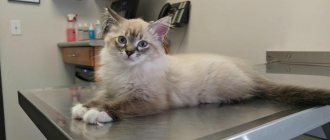In a modern city, a cat is one of the most beloved pets. A fluffy pet brings joy to its owners and creates coziness in the house. But at the same time it is a living being with its own needs inherent in nature. Some of them sometimes cause anxiety to their owners. For example, the need for procreation.
Adult cats can show aggression towards their relatives and leave scent marks, while cats during estrus disturb their owners with loud meows and attempts to sneak out of the house to find a partner. Not everyone has the opportunity and desire to raise kittens and then take on the hassle of finding new homes for the babies. Castration is one of the ways to prevent behavioral problems and the birth of unwanted offspring.
Castration or sterilization?
Often, pet owners confuse these concepts because both spaying and neutering prevent unplanned offspring. But from a veterinary point of view, these are different operations that differ in complexity and consequences for the body.
Sterilization
is needed only to ensure that the animal does not have offspring.
Veterinary medicine recognizes two methods
carrying out sterilization:
1. Chemical (medicinal)
A drug that suppresses sexual desire is injected under the animal's skin. The medication completely blocks the production of sex hormones for 2 weeks after administration. The effect of chemical sterilization lasts from 6 to 12 months. This method is used for working and hunting dogs, but is not recommended for animals with high breeding value, since artificial suppression of hormone production can lead to a malfunction of the endocrine system and, as a result, to infertility.
2. Surgical
An operation during which the spermatic cords of males are ligated, and the fallopian tubes of females are ligated.
After sterilization
animals lose the ability to give birth to offspring, but retain the instincts and behavior characteristic of unoperated representatives of their species.
During castration
In males, the testes are removed, and in females, the ovaries and uterus are removed.
Castration
most often removes behavioral problems associated with sexual desire: intraspecific aggression, sex markings, screaming, tendency to run away.
After castration
Animals not only lose the ability to reproduce, they completely lose their sex drive and the need for mating.
Positive effects of castration
Hormonal changes after removal of the testes and the operation itself under anesthesia have their pros and cons. There are many reasons to neuter a cat. This section will list the main ones.
There will be fewer threats to your pet's life
Unneutered cats are at the mercy of hormones. There are often cases when a family pet jumped out of a window. And it’s good if it’s not the fifth floor. In addition, many dangers await him on the street. Cars, dogs, people who don’t like a cat wedding outside their window.
Separately, it is necessary to say about cat fights for a lady’s heart. Another cat is unlikely to bite your pet, but he may well gouge out eyes, bite off an ear, or leave festering wounds. In the process of mating with stray cats, the pet may become infected. There are many dangerous viral diseases transmitted through blood and saliva. Finally, the animal will constantly suffer from worms and fleas.
Positive effect on cat behavior
Castration of an adult cat does not guarantee that he will become trained and amazingly obedient. Removing the testes does not affect habits, but it removes the irritant. This can seriously affect the pet’s character, as there will be fewer reasons for aggression, because the cat will no longer experience an unsatisfied need for a female.
Over time, habits may change, but changes in behavior will not occur earlier than in a month . Remember that the character of a cat largely depends on training; castration will not replace it, but will facilitate the process of learning new rules and skills. But the most important thing is that the cat will stop marking its territory. The fact is that marks are a way for a male to declare himself and lure a female, which is regulated by testosterone, so after castration the desire to mark will go away by itself.
Methods of castration
Castration of a cat
can be
partial (oophorectomy)
, when only the ovaries are removed, and
complete (ovariohysterectomy)
, when the ovaries are removed along with the uterus.
Ovariectomy can be performed in several ways:
- An incision of up to 3 cm along the linea alba of the abdomen is a common operation.
- Minimally invasive surgery through incisions on the sides, 1-2 cm wide, extraction of the ovaries with a hook.
- Laparotomy - organs are removed through a 0.5-1 cm puncture in the abdominal cavity.
Ovariectomy has become widespread because it seems to many to be a less traumatic operation, and is often advertised as such. In fact, castration with removal of the uterus can be performed in all of the above ways. However, a classic operation with a midline incision is preferable: the surgeon has an unlimited view, it is easier to perform manipulations, bleeding and pathologies are more likely to be immediately noticed.
Compared to spaying alone, removing the uterus and spaying carries less risk to the cat's future health. An oophorectomy leaves an unused organ in the body. This is the potential for neoplasms or pyometra (accumulation of pus as a result of inflammation of the endometrium), which will lead to the need for another operation.
In some cases, removal of only the ovaries by laparotomy with access through the lateral abdominal wall is a good alternative to complete castration. It is in this way that stray animals are often castrated, since after such an intervention the recovery period is easier and faster, and there is no need to wear a postoperative blanket.
Castration of a cat
can be performed
an open
or
closed
manner.
With the open castration method, the testes are removed after opening the vaginal membrane. To stop bleeding, ligation of the spermatic cord stump is used with a surgical thread (absorbable suture material is used) or the spermatic cord itself is tied into a knot without using a ligature.
The closed method of castration differs in that the vaginal membrane is not cut; the testis is removed along with part of it after applying a ligature.
In both cases, if the operation is performed correctly, no stitches are applied. The wounds become covered with a persistent scab after 1-2 days and heal completely within a week.
At what age can a kitten be neutered?
Surprisingly, such a not new and common operation as castration of domestic animals has been studied very little. There is virtually no scientific data regarding the optimal age for neutering cats or dogs.
For a long time, veterinarians recommended that cats be castrated between 6 months and 1 year of age. During this period, the animal begins puberty: in females the first estrus comes, in males the testes descend into the scrotum. The most obvious reason for this recommendation is the convenience of the operation: the organs of the reproductive system are quite large, the body is full of strength. However, if there is oversight on the part of the owner, a cat can already produce its first offspring at 8-10 months, which will have a bad effect on its further growth and development.
In foreign practice, earlier periods of castration are often recommended. This is largely due to the problems associated with the large number of stray animals and the need to control their birth rate. Many shelters in the United States and Canada now perform neutering surgeries for puppies and kittens before puberty, between 8 and 16 weeks of age. Breeders from these countries also began contacting veterinarians about early castration. Some of them prefer to sell pet-class kittens and puppies already neutered, which relieves some of the worries from their future owners.
How will spaying and neutering a kitten help?
Sterilization and castration of a kitten is a safe operation, provided that it is carried out by a specialist in a veterinary clinic. These procedures have many advantages.
Both methods help control the cat population. For example, spaying and neutering outdoor cats helps reduce the number of homeless animals.
Since castration involves the removal of genitals, there are health benefits:
- Males have a reduced risk of contracting feline immunodeficiency virus (this is like human HIV).
- Neutering prevents testicular cancer and prostate problems in males.
- Neutering prevents uterine infections and mammary tumors in cats.
- It is less likely that your pet will run away from home in search of a partner.
- Most cats stop marking their territory and become generally calmer.
Preparing a kitten for early castration
There is a certain list of actions to prepare babies for the early castration procedure:
- According to the recommendations of the Federation of Veterinarians of Europe (FVE), a kitten should not be castrated before weaning, that is, the operation should not be performed before it reaches the age of 2 months.
- Kittens should not be kept on a fasting diet for more than 2-3 hours and should not be allowed to drink. Water can be given even immediately before surgery.
- The veterinarian examines the kitten, thermometry and auscultation of the heart. If during auscultation the doctor hears pathological noises, he may refer you for examination to a cardiologist. In the absence of pathologies during auscultation, an ECG or echocardiogram of the heart is not mandatory and remains at the discretion of the doctor.
- Weighing is always carried out. The kitten must weigh at least 500 grams.
- A clinical blood test of the kitten is performed.
- Vaccination according to age should be carried out no later than 10 days before castration or no earlier than 10 days after it.
- The choice of methods of anesthesia and analgesia is always made by a doctor depending on the condition of the animal. All drugs are dosed strictly according to the weight of the animal.
How does puberty occur in kittens?
When kittens reach sexual maturity, they begin to look for a mate. This happens at the level of instincts. In males, maturation occurs at the age of 9-12 months, in females - at 5-6 months. In some cats, maturity may occur earlier or much later, depending on many factors (including the time of year the cat is born).
Signs of puberty in male kittens:
- the kitten begins to mark its territory;
- the kitten becomes restless, sometimes aggressive, meows a lot and loudly;
- If a kitten is allowed to walk on its own, it may not appear at home for several days or fight with neighbor cats.
Signs of puberty in female kittens:
- the pet leaves marks;
- becomes restless, as if she is constantly looking for something;
- the cat meows loudly;
- behavior becomes unpredictable;
- the cat raises its tail and rolls on the floor,
- A cat that is usually not interested in the street may try to run away in search of a partner.
Pros and cons of early castration
Castration is a serious operation, although it has been practiced by veterinarians. The need for it should be carefully considered by the animal owner. If the owner is sure that he does not intend to engage in breeding, and the animal has no contraindications to the operation, the issue of the timing of its implementation needs to be resolved. Early castration has both advantages and disadvantages compared to castration done later in life.
Advantages of early castration:
- Castration, carried out before the kitten is taken from the nursery or shelter to a new home, prevents uncontrolled reproduction.
- Early castration reduces the likelihood of unwanted behavior. Such as urine marking, urinating in the wrong place and aggression.
- Early castration significantly reduces the risk of developing mammary tumors in cats.
- Prevents diseases of the reproductive system (purulent inflammation of the uterus (pyometra), ovarian cysts, uterine tumors, etc.) in cats.
- Prevents prostatitis and prostatic hyperplasia in cats.
- Reduces the likelihood of asthma and gingivitis.
Possible negative consequences
Animal owners are often concerned about the question of whether it is justified to put the still unformed body of a small kitten at risk. Most often, they name 2 main factors that force one to treat early castration with caution:
1. Risk of complications during anesthesia
Currently, the drugs used in anesthesia are safe for puppies and kittens from six weeks of age. In addition, before the operation, the kitten will be examined by a veterinarian; thermometry, laboratory blood tests will also be performed, and, if necessary, a heart examination will be performed. The kitten will be allowed to undergo surgery only if there are no contraindications.
Most studies show that compared to castration at a later age, early castration is easier for animals to tolerate. Young patients recover faster after surgery.
2. Long-term undesirable consequences:
- Obesity
There is an opinion among dog and cat owners that castrated animals quickly gain weight. In fact, not all animals are predisposed to obesity after surgery. In any case, your animal will not gain weight as long as it is fed sensibly and provided with conditions for movement. During laboratory observations, it was found that castrated cats require 28%, and neutered cats 33% less calories to maintain normal body weight than before surgery. Several studies focusing on age at neutering and obesity in cats show that neutering at 7 weeks of age reduces the risk of obesity compared to neutering at 7 months. Kittens castrated at an early age do not gain excess weight until the end of the growth period. In the future, they require caloric restriction in their diet, just like animals operated on after puberty. Currently, animal food manufacturers produce special foods for sterilized kittens, which take into account the characteristics of the development and growth of animals after early castration. An example of such food PRO PLAN® STERILISED KITTEN FOR STERILIZED KITTENS, WITH A HIGH SALMON CONTENT.
- Decreased growth.
It was previously thought that puppies and kittens neutered before 6 months of age may subsequently be smaller in height and size than their unneutered peers. Research has proven that this is not the case. X-rays carried out in groups of cats castrated at the age of 7 weeks, 7 months and uncastrated showed that the closure of growth plates on the radius and ulna bones in castrates of both groups occurs later than in uncastrated animals. However, the difference in bone length in cats of all three groups was insignificant and fell within normal limits. From this we can conclude: instead of causing a cessation in growth, early castration can lead to both normal growth and increased growth.
- Predisposition to diseases of the urinary system
For quite a long time, an argument against early castration has been that this procedure can increase the risk of developing urolithiasis in cats, since the development of the genitourinary organs slows down and the diameter of the urethra remains small, which impairs its patency. Contrary to this opinion, data from a radiopaque study of the urinary tract conducted at the University of Florida showed that the diameter of the urethra in cats castrated at 7 weeks, 7 months and uncastrated was almost the same, although the external genitalia in castrated cats of both groups remained underdeveloped compared to uncastrated animals. .
- Irreversibility of castration
One of the obvious disadvantages of castration is the irreversibility of the procedure. At the age at which early castration is carried out, it is not always possible to accurately assess the animal’s exhibition potential and its value for breeding. After the operation, even if the owner wants to restore the reproductive function of the pet and get offspring from it, it will be impossible to do this. However, the opinion that if a cat has not given birth, and the cat has never participated in mating, they will be physically less healthy than their relatives participating in reproduction, has not been confirmed during numerous observations of animals. The necessity of childbirth and mating for animal health is a myth.
- Decreased activity
Sometimes you can hear the opinion among dog and cat owners that early neutered animals have poorer health, are less active and playful, do not strive to communicate with the owner and relatives, and are less amenable to training. Results from a 37-month study of 263 neutered shelter cats tell a different story. The cats were divided into two groups - neutered before 24 weeks of age and after. Researchers conducted telephone surveys of new owners and took into account medical records. It turned out that cats that underwent early castration did not get sick more often and adapted to their new home in the same way as others.
According to the results of another study conducted by the University of Minnesota, it turned out that the behavioral characteristics of cats castrated at 7 weeks and at 7 months were similar. Neutered cats of both groups willingly communicated with people and did not show indifference to other animals. Compared to them, uncastrated cats showed less affection for humans and more aggressiveness.
Another large-scale study that followed early neutered cats for many years found that after early neutering, animals are more likely to grow up timid and less likely to become hyperactive, compared to animals neutered after 6 months. It was also noted that the incidence of aggression towards both people and members of their own species in adult cats neutered at an early age was significantly reduced compared to the same rates in cats neutered later. From this we can conclude that castration, including early castration, changes behavior: it reduces intraspecific and interspecific aggressiveness, but does not make the animal apathetic and lethargic.
"EXPOCOT 2011" - PRESENTATION OF THE BURMAN BREED
Burmese cats are luxury, exclusivity, grace and charm!
Burmese cats are the embodiment of natural harmony, beauty and perfection! These cats are elegant, have a refined appearance, in which simplicity is adjacent to nobility.
The main feature of the European Burmese breed is its short, glossy, tight-fitting coat, silky to the touch. The coat of Burmese cats is smooth, shiny, reminiscent of satin, and has a palette of colors unique to this breed - brown (sable), chocolate (champagne), lilac (platinum), blue. The brightest and most eye-catching color of Burmese cats is brown, also known as sable. But touching the fur of a Burmese cat evokes even greater delight. It seems as if the most expensive silks of the East are enveloping your palm. Each hair, colored from the root to the very tip, fits tightly to the cat's body. The fur softly shines and shimmers with every movement of the animal. Touching this luxury, you forget all your affairs and problems, and you can no longer deny yourself the pleasure of holding this miracle in your hands.
The character of the Burmese cat is no less unique than its colors and it can be safely called its main advantage. European Burmese are very friendly and playful animals. These cats love the company of people very much, which is why, in terms of their attitude towards people, they are often compared to dogs. The well-known saying that a cat walks on its own has nothing to do with Burmese cats. This cat has a completely unique feature - a genetic taboo on human skin, therefore the Burmese cat is not capable of aggression towards humans and under no circumstances does it scratch or bite. The European Burmese is absolutely non-aggressive, patient in relationships with children, and easily learns the rules of behavior, thanks to its high intelligence. It is thanks to its character that the European Burmese is becoming more and more popular every day almost all over the world. European Burmese are all elegance, grace and tact. Her boundless love, tender and touching attitude towards people amazes and surprises.
I will be glad to introduce you to my animals, tell you about their achievements, show many wonderful photographs, share useful information, and maybe help you find a little loving friend.
The nursery is engaged in breeding only the breed of cats - EUROPEAN BURMA (Burmese).
I tried to find for you a lot of interesting and useful information about the Burmese breed:
- history of the Burmese breed
- Burmese breed standards
- Burmese pedigree database
- main differences between European and American Burmese cats
- family tree of the ancestors of the Burmese breed
- gallery of photos of kittens (European Burmese)
- film about Burmese apartments
- care, maintenance and feeding of kittens (European Burmese)
- articles about the Burmese breed
- stories of happy kitten owners (European Burmese)
- rules for selling kittens
- contract for the sale of kittens and much, much more!
°°°°°°°°°°°°°°°°°°°°°°°°°°°°°°°°°°°°°°°°°°°°°°°°°°°°°°°°°°°°°°°°°°°°°°°°°°°°°°°°
Castration and behavior problems
Regardless of the age at which the operation is performed, castration does not guarantee relief from all behavioral problems. Animals from birth are noticeably different from each other in character and temperament, so it is impossible to accurately predict how a pet’s behavior will change after castration. Many cats become calmer, life next to them becomes more comfortable for their owners. However, even neutered animals can exhibit aggression and unpleasant habits that are usually associated with sexual behavior. The cause of such troubles is often not the animal’s bad character, but health problems or lack of upbringing.
Possible complications
Some owners are afraid of the consequences of surgery that may happen to their pet.
Obesity
There is a chance that a cat will gain weight after castration. But this can be easily avoided by understanding the nature of this phenomenon. The animal gets fat because it has nowhere to spend energy. Previously, he looked for the cat day and night, but now he only eats and sleeps. In order for the cat to always be in shape, the owner needs to take care of this:
- Provide exercise for the cat. Buy toys, spend time with him, play actively. You can get a second cat so that he has someone to play with. It is very useful to take the animal outside. You need to understand that in the wild, cats lead very active lives.
- Feed less. Reducing the diet will not harm the cat. Castrated animals need 25-30% less energy, as their metabolism changes. Food should be less caloric. By choosing the right diet and portions, you can control your pet’s weight.
Urolithiasis disease
Castration itself is not the root cause of urolithiasis (UCD). But it can aggravate and accelerate its development. UCD is the deposition of minerals in the bladder/kidneys due to excess, deposits or improper metabolism. It must be remembered that predisposing factors are obesity and a sedentary lifestyle.
If you walk and play with the animal, as well as control its weight and diet, you can reduce the risk of developing urolithiasis to a minimum. If you overfeed your pet after castration, this will contribute to the deposition of minerals. Low fluid intake also has a negative effect; water should always be available to the cat.
Conclusions:
Early castration of kittens is a convenient way to control the reproduction of cats and helps reduce the number of unwanted and neglected animals.
At the current level of development of veterinary medicine, early castration does not pose a greater danger to the pet’s body than an operation performed later.
The risk of long-term negative consequences of early castration for the health of the animal is no different from what accompanies this operation at an older age. At the same time, early castration is a reliable means of preventing certain diseases.
Numerous studies and extensive experience from North American shelters show that early neutering does not have a negative impact on the physical development and behavior of a cat.
Many factors influence a cat's behavior. Neutering can help eliminate some of the behavioral problems, but after castration, animals need the same attention from their owners and proper training as before.









